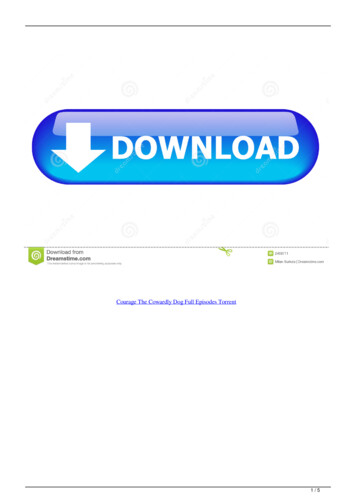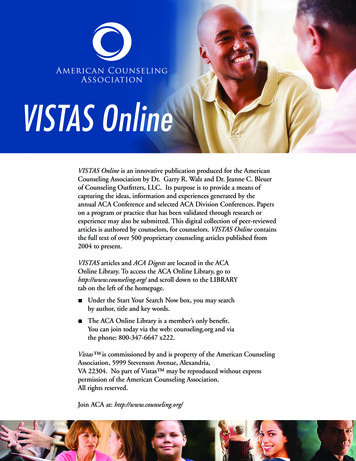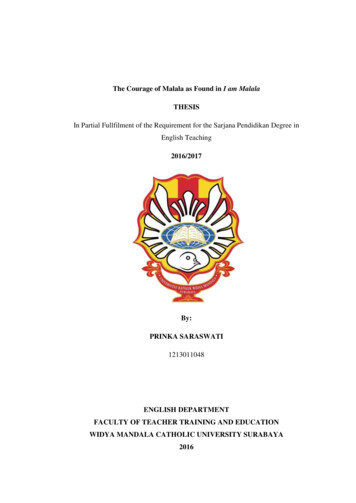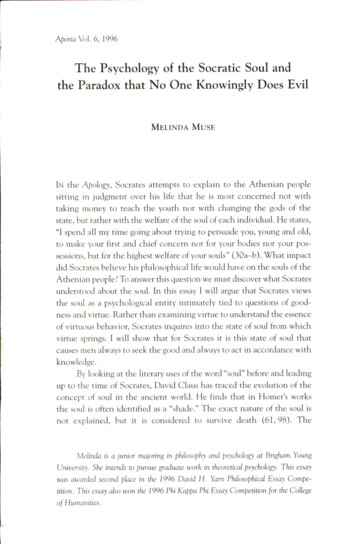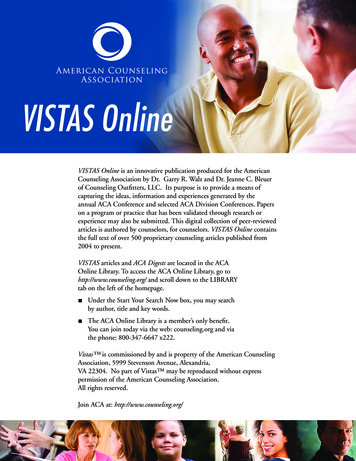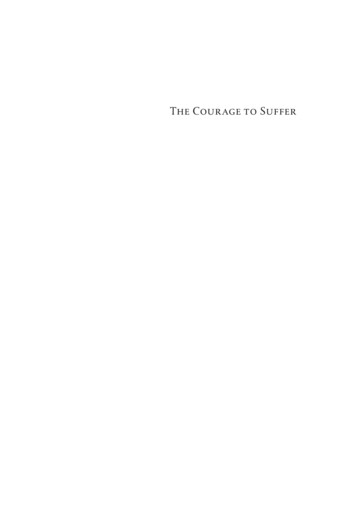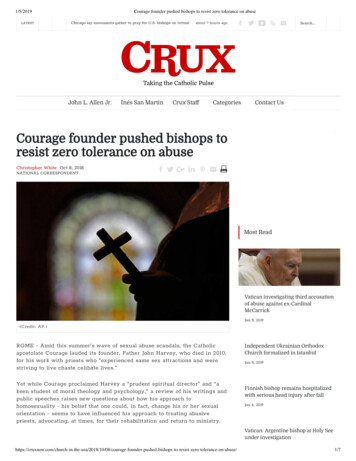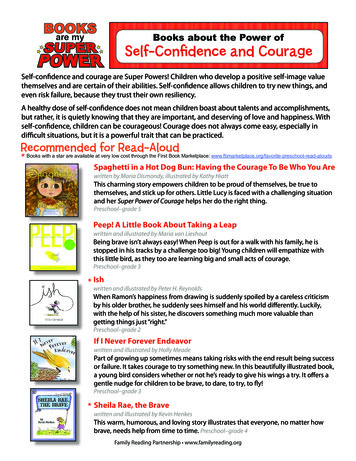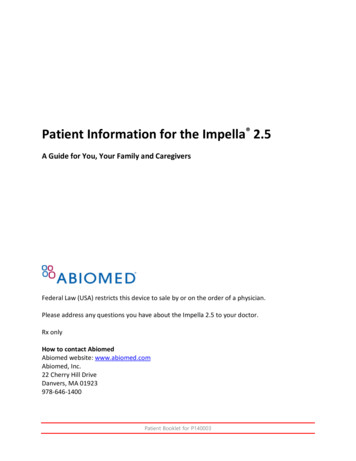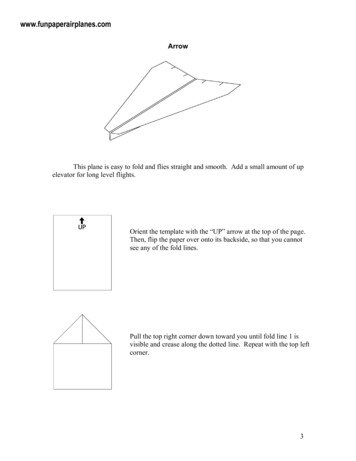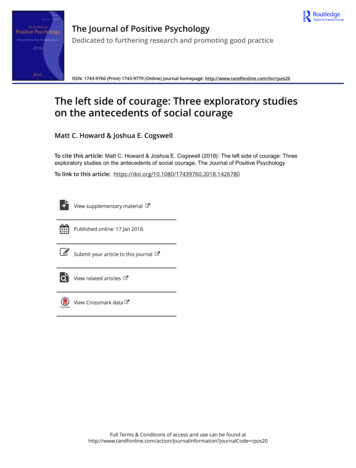
Transcription
The Journal of Positive PsychologyDedicated to furthering research and promoting good practiceISSN: 1743-9760 (Print) 1743-9779 (Online) Journal homepage: http://www.tandfonline.com/loi/rpos20The left side of courage: Three exploratory studieson the antecedents of social courageMatt C. Howard & Joshua E. CogswellTo cite this article: Matt C. Howard & Joshua E. Cogswell (2018): The left side of courage: Threeexploratory studies on the antecedents of social courage, The Journal of Positive PsychologyTo link to this article: https://doi.org/10.1080/17439760.2018.1426780View supplementary materialPublished online: 17 Jan 2018.Submit your article to this journalView related articlesView Crossmark dataFull Terms & Conditions of access and use can be found tion?journalCode rpos20
The Journal of Positive Psychology, he left side of courage: Three exploratory studies on the antecedents of socialcourageMatt C. Howard and Joshua E. CogswellMarketing and Quantitative Methods, The University of South Alabama, Mitchell College of Business, Mobile, AL, USAABSTRACTCourage has been linked to important workplace outcomes, but little is known about theantecedents of courage. To identify possible methods to develop a more courageous workforce,the current article provides initial evidence regarding the antecedents of behavioral social couragefrom five broad categories: personality, job characteristics, leadership, culture, and demographiccharacteristics. Three exploratory studies show that certain antecedents from these categorieshave a significant relationship with behavioral social courage, including grit, proactive personality(personality), social support (job characteristics), empowering leadership (leadership), powerdistance (culture), and age (demographics). Perceived courage benefits and risks did not mediatethe effect of most antecedents on behavioral social courage. These results suggest that certainantecedents may influence behavioral social courage, but the mediators of these relationshipsremain unknown. Further implications and directions for future research are discussed.The importance of courage has been recognized throughout history, dating back to the works of Plato and Aristotle(Hobbs, 2000; Snyder, Lopez, & Pedrotti, 2010). These earlier works often stressed the importance of courage forextreme occasions, such as leading during war, but recentworks have argued that courage may be important foreveryday interactions – particularly within the workplace(Koerner, 2014; Pury & Lopez, 2010; Schilpzand, Hekman, &Mitchell, 2014). An employee may need courage to reportthe abusive supervision of their supervisor, or a supervisormay even need courage to provide an honest performancereview of a subordinate. Further, earlier works often provided vague definitions for the construct, such as ‘persistence despite fear’ (Howard & Alipour, 2014; Norton & Weiss,2009), but more recent works have applied sophisticatedempirical methods to identify theoretically- and empirically-supported definitions for courage (Pury, Brawley, Lopez,& Burnett, 2016; Pury, Kowalski, & Spearman, 2007; Rate,2010; Rate, Clarke, Lindsay, & Sternberg, 2007). Perhapsthe most supported definition was created by Rate andcolleagues (2007; Rate, 2010). This definition specifies thatcourage is a ‘(a) willful, intentional act, (b) executed aftermindful deliberation, (c) involving objective substantialrisk to the actor, (d) primarily motivated to bring about anoble good or worthy end’ (Rate et al., 2007, p. 95). A person that repeatedly performs such behaviors is believedKEYWORDSCourage; positiveorganizational behavior;traits; prosocial behaviors;positive psychology;personalityto possess the trait of courage (Pury & Starkey, 2010; Rate,2010; Rate et al., 2007).Recent studies have begun to empirically study courage’s influence on work outcomes (Howard, Farr, Grandey,& Gutworth, 2016; Koerner, 2014; Schilpzand et al., 2014).Koerner (2014) provided a theoretical model suggestingthat courageous behaviors influence employees’ personalidentities, which subsequently influence the behaviors thatthey choose to perform. Qualitative evidence supportedthis proposal, showing that courage behaviors indeedinfluence subsequent behavioral outcomes (Koerner,2014). Howard and colleagues (2016) quantitativelyshowed that social courage, one of the many possibledimensions of courage, significantly relates to organizational citizenship behaviors and prosocial rule breakingeven when controlling for conscientiousness. From thesefindings and others (Baumert, Halmburger, & Schmitt,2013; Hannah, Avolio, & Walumbwa, 2011), authors havesuggested and empirically supported that courage relatesto many important work outcomes.Despite these important findings, much less researchhas considered the antecedents of courage (Koerner,2014; Schilpzand et al., 2014); few authors have empirically studied possible antecedents (Howard et al., 2016);and Detert and Bruno (2017) directly call for research onthe antecedents of courage in their recent review. In otherCONTACT Matt C. HowardMhoward@SouthAlabama.eduSupplemental data for this article can be accessed https://doi.org/10.1080/17439760.2018.1426780. 2018 Informa UK Limited, trading as Taylor & Francis GroupARTICLE HISTORYReceived 14 June 2017Accepted 14 December 2017
2 M. C. HOWARD AND J. E. COGSWELLwords, very little is known about ‘the left side’ of courage.To prompt the wider study of courage’s development,the goal of the current article is to provide an exploratory investigation into (a) the possible antecedents ofcourage and (b) the manner in which these antecedentsmay influence behavioral courage. In doing so, we studyantecedents from five broad categories (personality, jobcharacteristics, leadership, culture, and demographiccharacteristics), and we test whether perceived couragebenefits and risks serve as mediators of these relationships. Providing initial inferences regarding the antecedents of courage may allow future research to conductmore directed studies to identify how courage can bedeveloped. This would subsequently allow businessesto foster conducive environments, which could benefitthe success of the organization as well as the employeesthemselves.To achieve these goals, the current article first providesa review of courage. Second, the current article identifiesa dimension of courage with a sufficient theoretical basisand existing measurement, social courage, which indicatesthat it is prime for empirical research. Third, three empirical studies are performed to identify the relationship ofpossible antecedents with behavioral social courage andpossible mediators. Fourth, these findings are integratedwith prior research and suggestions are provided for thecontinued study of the left side of courage.BackgroundCourage and social courageCertain aspects of courage should be considered beforeidentifying possible antecedents. As mentioned, courage isoften defined as a type of act or behavior, but it is also considered a trait. Pury and Starkey (2010) consider this the difference between courage as a process and courage as anaccolade. Most early definitions of courage treated it onlyas a trait (e.g. as an accolade), and the label was reservedfor those that were different from the rest (Peterson &Seligman, 2004; Pury & Starkey, 2010; Rate, 2010). Theselabels, however, often applied vague descriptions thatcould not be clearly applied, and the definitions did notaccurately identify those commonly believed to possesscourage (Peterson & Seligman, 2004; Pury & Starkey, 2010;Rate, 2010). For this reason, definitions were developedthat treated courage as a process.Definitions of courage as a process can be seen acrossseveral disciplines (MacIntyre, 1981; McCain & Salter, 2004;Rate, 2010), and they are commonly used in descriptions ofawards for courage (i.e. The Carnegie Medal, The Couragein Journalism Awards; Pury & Starkey, 2010). Of thesedefinitions, Rate and colleagues′ (2007; Rate, 2010) definition is perhaps the most popular and supported, whichspecifies four primary aspects of a courageous behavior:(a) intention, (b) deliberation, (c) risk, (d) and noble intentions. While the term ″noble″ has been treated in severaldifferent manners, researchers often consider it to be synonymous with prosocial (Howard & Alipour, 2014; Howardet al., 2016; Rate, 2010). The same perspective is taken inthe current article. Further, a behavior that includes thesefour elements is considered a courageous act, and a personthat repeatedly performs these behaviors is then considered to possess trait courage (Rate, 2010; Rate et al., 2007).Thus, Rate and colleagues’ (2007; Rate, 2010) definition isable to identify courage as a trait as well as a behavior.In research, a greater attention has been paid to traitcourage (Howard et al., 2016; Norton & Weiss, 2009; Pury &Starkey, 2010; Rate, 2010), perhaps due to the historic focuson courage as an accolade. In the current article, however,the antecedents of behavioral courage are explored. In thetraditional method to gauge trait courage, participantsrespond independently of their context (i.e. work environment; Howard et al., 2016). As further detailed below, wegauge courage by asking participants to respond specifically to their behaviors in their current work environment,which we consider to be a measure of behavioral courage(Pury & Starkey, 2010).We analyze behavioral courage for three primary reasons. First, prior studies of courage as a trait does not preclude the study of courage as a behavior. As mentioned,conceptualizations of trait courage are predicated on theoccurrence of courage behaviors, and thereby courage asa behavior is implicit in these prior studies of trait courage.Second, behavioral manifestations of courage, as opposedto the latent trait of courage, have a direct influence on theworkplace, and these behavioral manifestations are moreproximal to workplace outcomes that are important forboth research and practice. Third, behavioral courage isbelieved to be more malleable than trait courage, whichwould be more likely to be influenced by antecedents.Thus, behavioral social courage may be more relevant tothe study of antecedents than trait social courage.Additionally, courage is a multidimensional construct(Lopez et al., 2010; Sekerka, Bagozzi, & Charnigo, 2009).Some authors have differed on their methods to identifythese dimensions, but most consider the dimensions tobe differentiated by the risks (i.e. physical courage, socialcourage) or goals (i.e. moral courage) involved in a behavior rather than the context (i.e. work courage, war courage)or person performing the behavior (i.e. managerial courage, subordinate courage; May, 1994; Schilpzand, 2008;Woodard & Pury, 2007). From categorizing risks, authorshave consistently identified three types of courageousbehaviors that may be important to workplace interactions: physical, moral, and social courage (Howard et al.,2016; Sekerka & Bagozzi, 2007).
THE JOURNAL OF POSITIVE PSYCHOLOGY Physical courage is an intentional, deliberate, andprosocial behavior in which the risks involved are to theactor’s physical well-being (Clancy, 2003; Olsthoorn, 2007;Woodard & Pury, 2007). While physical courage was regularly discussed in early works, as these works often discussed courage on the battlefield (Hobbs, 2000; Snyder etal., 2010), recent authors have argued that it may not benecessary for modern society – especially the workplace(Clancy, 2003; Kidder, 2003; Lachman, 2007). These authorsargue that modern employees rarely need to sacrifice theirphysical well-being for the betterment of their companyor coworkers (Clancy, 2003; Kidder, 2003; Lachman, 2007).While this point is arguable, it emphasizes that physicalcourage may be less important to organizations than othercourage dimensions.Next, moral courage is often discussed in research, buta widely-supported definition has yet to be provided forthe construct. Some definitions do not clearly distinguishmoral courage from general courage or other ethics-related individual differences (Brooks & Edwards, 2009;Niesta, Greitemeyer, Fischer, & Frey, 2010). Examples ofthese definitions are ‘willingness to take a controversialstand’ (Corley, 2002, p. 647) or ‘acting according to values’ (Callister & Sudia-Robinson, 2011, p. 3). Other definitions define moral courage as overcoming risks to others(Simola, 2015), addressing norm violations (Baumert et al.,2013; Halmburger, Baumert, & Schmitt, 2015), expressingauthenticity (Pianalto, 2012; Worline, 2012), or even courage in extreme situations (Comer & Vega, 2015; Oliner,1991). Without a widely-supported construct definition,it is difficult to empirically study moral courage, and otherdimensions of courage may be more appropriate to study.It should be noted, however, that moral courage is likely animportant dimension to study, especially once a definitionhas been more widely agreed-upon.Lastly, social courage is an intentional, deliberate, andprosocial behavior in which the risks involved are to theactor’s esteem in the eyes of others (Howard et al., 2016).Social courage is often included in authors’ proposeddimensions of courage (May, 1994; Schilpzand, 2008;Woodard & Pury, 2007), which provides support for thevalidity of the construct. Also, social courage has been suggested to be the most important dimension of courageto the modern workplace (Geller & Veazie, 2009; Howardet al., 2016; Koerner, 2014; Worline, 2012). Employeesare regularly tasked with risking their friendships withcoworkers and/or social image for the betterment oftheir organization, coworkers, or even self. For instance,many employees are afraid to give presentations at work(Geller & Veazie, 2009; Koerner, 2014; White et al., 2015),but the results of a presentation may significantly impactthe direction of a work unit or even organization. Further,3research has already empirically shown that social courageis significantly related to important workplace outcomes,and a psychometrically sound and valid measure existsto measure this dimension of courage in the context ofthe workplace (Howard et al., 2016). Thus, social courageis important to organizations, and it can be empiricallystudied using existing measures.Due to these considerations, the current article studiesthe antecedents of behavioral social courage. It is believedthat the antecedents may also relate to other dimensionsof courage, but any findings would still be important dueto their relation to social courage alone.Categories of antecedentsMany motivational theories (i.e. expectancy theory; Vroom& Jago, 1988, 2007; Vroom & Yetton, 1973), leadership theories (i.e. path-goal theory; House, 1971; House & Mitchell,1975), need-based theories (i.e. Maslow’s hierarchy;Maslow, 1943, 2013), and a host of other theoretical perspectives all propose that people weigh the costs and benefits of their goal-directed actions. Accordingly, cognitivemediational theory suggests that this cognitive appraisal– which may happen automatically and subconsciously –is a response to a stimulus in the environment that mayrequire action (Lazarus, 1991). This appraisal then elicits aphysiological arousal and an emotional response, whichmay also influence subsequent emotional responses if thestimulus returns. Current empirical research has repeatedlysupported these notions and shown that perceptions ofbenefits and risks are a primary determinant of goal-directed risky behaviors (Foster, Shenesey, & Goff, 2009;Moore & Gullone, 1996; Zhang, Zhang, & Shang, 2016).Similar dynamics may be true for courage. Benefitsand risks are central to most all definitions and theoretical models of courage (Hannah, Sweeney, & Lester, 2007;Koerner, 2014; Quinn & Worline, 2008; Rate et al., 2007;Schilpzand et al., 2014; Worline, 2004, 2012). Sekerka andBagozzi (2007), for example, suggest that an initial stepto performing a courageous action is having an affectivereaction and cognitively processing information. Affectiveresponses are greatly influences by prior beliefs regardingassociated risks and benefits, which results in cognitiveprocesses that more directly weigh these two aspects.From these perspectives, people may habitually performcourageous behaviors because they particularly value thebenefits and/or devalue the risks involved, which has beeninitially supported by Brandstätter and colleagues (2016).These authors viewed courage as a goal-directed process,in which people must perceive the severity of a norm violation that can be rectified (e.g. potential benefits) and theextent of risk involved with intervening. The authors then
4 M. C. HOWARD AND J. E. COGSWELLshowed that certain values and self-regulatory affectivetraits influence these perceptions, but no indicators ofcourage were measured.Consistent with these perspectives and findings, weargue that cognitive appraisals of the potential risks andbenefits of social courage behaviors are a critical step in theprocess of enacting courage in the social context. To illustrate this point, we consider the following example fromthe Workplace Social Courage Scale (WSCS; Howard et al.,2016): ‘Although it may damage our friendship, I would tellmy superior when a coworker is doing something incorrectly.’ The respondent has witnessed something that mayresult in negative consequences for the organization, andthe courageous action is to tell the supervisor of this incorrect behavior. In deciding whether to act, the person mustweigh the perceived risk (i.e. damaging a friendship with acoworker) with the potential benefit (i.e. remedy of duress)of performing the action.Based on this proposal, we identify antecedents thatmay influence how people appraise risks and benefitsassociated with social courage behaviors. To study socialcourage in a systematic manner, the current article identifies five categories of antecedents. These categoriesare based on prior discussions of courage’s antecedents(Schilpzand et al., 2014) as well as prior investigations intothe antecedents of similar constructs, such as psychological capital (Avey, 2014; John & Srivastava, 1999; Mowen &Carlson, 2003; Thatcher & Perrewe, 2002).The first category of antecedent is personality. Otherindividual differences may impact the decision to performa courageous behavior aside from trait courage – particularly those that describe a tendency to work throughdifficulties despite personal risks (i.e. risk of failure). Gritdescribes a predisposition toward perseverance and passion for long-term goals (Duckworth, Peterson, Matthews,& Kelly, 2007). Those high in grit may be more likely topersist through perceived risks (i.e. damage to friendship)in the interest of accomplishing longer-term goals, suchas the alleviation of duress in the organization. Proactiveindividuals are similarly known to persist through difficulties (Bateman & Crant, 1993). As part of the appraisal process (Lazarus, 1991), individuals assess whether they havesufficient resources to meet the threat. High-grit and/orproactive individuals may be more likely to judge their psychological resources sufficient to withstand any adverseconsequences of courageous action. Thus, we propose thefollowing hypothesis:Hypothesis 1: (a) Grit and (b) proactive personality arepositively related to behavioral social courage.The second category is job design characteristics. Jobcharacteristics are aspects of employees’ work environment, and include autonomy, skill variety, task identity, andothers (Hackman & Oldham, 1976; Oldham & Hackman,2010). Job characteristics theory (Hackman & Oldham,1976; Oldham & Hackman, 2010) and various work designmodels (Fried & Ferris, 1987; Humphrey, Nahrgang, &Morgeson, 2007; Morgeson & Humphrey, 2006) suggestthat certain aspects of employees’ work environmentdirectly influence their affect, attitudes, intentions, andbehaviors (Humphrey et al., 2007; Morgeson & Humphrey,2006; Oldham & Hackman, 2010). With regard to behavioral social courage, social support may be a particularlyrelevant job characteristic.Employees with high levels of social support may viewtheir relationships as a resource to buffer against such consequences. An employee with few supportive relationshipsmay be unwilling to damage their few social relationships,whereas an employee with many supportive relationshipsmay believe that their social support can withstand shortterm conflicts. Also, employees with ample social supportmay believe that their strong social networks can alleviateany damage to their ‘esteem in the eyes of others.’ Thus,we propose:Hypothesis 2: Social support is positively related to behavioral social courage.The third category is leadership. Certain leadershipstyles may influence followers’ expression of traits (Afolabi,Adesina, & Aigbedion, 2009; Colbert & Witt, 2009; Perry,Witt, Penney, & Atwater, 2010). For instance, Colbert andWitt (2009) empirically demonstrated that goal-focusedleadership helps enable the expression of subordinates’conscientiousness. Schilpzand and colleagues (2014)specifically propose that this process occurs with courageous behaviors via self-perceptions. That is, certain external influences, including leadership, may elicit positiveself-perceptions, which may cause employees to performcourageous behaviors – possibly because these employeesfeel more resilient to the risks involved with these behaviors. More directly, a host of prior authors have suggestedthat leadership plays a primary role in the performanceof courageous behaviors (Hannah et al., 2013; Hannah etal., 2007; Sekerka & Bagozzi, 2007; Sekerka et al., 2009).Leaders have the power to reduce the risks involved withcourageous action, such as preventing retaliatory consequences, but leaders can also amplify the risks involvedwith courageous actions, such as belittling or directlypunishing (Hannah et al., 2013; Snyder, 2010; Terry, 1993).Positive aspects of leadership, such as ethical andempowering styles, have both been suggested to influence follower proactive and prosocial behaviors, of whichcourageous behaviors are included (Hannah et al., 2011;Waldman, Siegel, & Javidan, 2006; Zhu, May, & Avolio,2004). On the other hand, abusive supervision has beensuggested to reduce proactive and prosocial behaviors(Conger, 1999; Hannah et al., 2013; Waldman et al., 2006;Zhu et al., 2004). Thus, we propose:
THE JOURNAL OF POSITIVE PSYCHOLOGY Hypothesis 3: (a) Ethical leadership and (b) empoweringleadership are positively related to behavioral socialcourage. (c) Abusive supervision is negatively related tobehavioral social courage.The fourth category is cultural influences. Culturerepresents a belief system that is shared by membersof a group (Hofstede, 2006; Hofstede & Hofstede, 2001;House, Hanges, Javidan, Dorfman, & Gupta, 2004). Whilecultural influences are often analyzed across groups, suchas comparing participants from Eastern and Western cultures, cultural beliefs may vary within a single culture(Avey, 2014; Kashima et al., 2004; Schug, Yuki, & Maddux,2010). Further, culture has a strong influence on groupmembers’ typical patterns of behaviors, which may eveninclude courageous behaviors as suggested by Sekerkaand Bagozzi (2007). While several different aspects of culture may influence courage, the most proximal are likelythose related to interpersonal interaction (Hobfoll, 2001;Hofstede, 2006; Hofstede & Hofstede, 2001; Hofstede& McCrae, 2004; House et al., 2004). One such culturalinfluence is humane orientation. Cultures with a humaneorientation reward each other for fair and altruistic treatment. In these cultures, members may feel that retaliationfor social courage behaviors is unfair, as these behaviorshave a prosocial intent – thereby promoting the performance of such behaviors. Likewise, members of thesecultures particularly value the prosocial treatment of others, and social courage may be actively promoted dueto the helping nature of this type of behavior. For thisreason, we propose:Hypothesis 4: Humane orientation positively relates tobehavioral social courage.Lastly, the fifth category is demographic characteristics. Throughout history, courage has often been treatedas a gendered concept (Hobbs, 2000; Pury & Lopez,2010; Snyder et al., 2010). That is, men are expected toexpress courageous behaviors, such as rushing into battle, whereas women are not expected to perform suchbehaviors. While this notion is largely based on conjecture and speculation (Pury & Lopez, 2010; Snyder etal., 2010), gender may still influence the expression ofbehavioral courage through social conditioning. Also,employees may grow bolder and become more courageous as they spend more time in an organization,causing age and/or tenure to also relate to behavioralcourage. While organizations may be largely unableto influence demographic characteristics to promptcourage, these relationships could still have importantimplications. Particularly, organizations could include ameasure of courage in selection batteries. If courage isrelated to certain demographic characteristics, such as a5legally protected class status, then its inclusion in selection batteries could result in disparate impact – a concernthat would need to be addressed. For these reasons, wepropose that:Hypothesis 5: (a) Gender, (b) age, and (c) tenure relate tobehavioral social courageTogether, these five categories of antecedents (personality, job characteristics, leadership, culture, anddemographic characteristics) are investigated to prompta more systematic study of the left side of social courage.We recognize, however, that each of these categoriescontain other possible antecedents that were not directlyhypothesized. Therefore, we also investigate other possibleantecedents from these categories without firm a priorihypotheses.Research Question 1: Which other antecedents relate tobehavioral social courage?MediatorsThe current article proposed that each antecedent influences behavioral social courage via perceived risks andbenefits. For this reason, we test whether perceived risksand benefits are dual mediators between various antecedents and behavioral social courage. By doing so, we canprovide a more in-depth understanding regarding the roleof perceived risks and benefits in social courage actions,which may also provide insights on courage as a goal-directed process.Hypothesis 6: Perceived risks and benefits mediate therelationship between antecedents and behavioral socialcourage.Overview of studiesThe current article investigates five categories of courageantecedents, each with several predictors. Participantfatigue could be a concern if each of these antecedentswere analyzed simultaneously, which would result inrandom responses, dropout, and biased results (Blasius& Thiessen, 2015; Egleston, Miller, & Meropol, 2011). Forthis reason, the current article provides three studies.Personality, job characteristics, and demographics areanalyzed together in Study 1. Leadership, culture, anddemographics are analyzed together in Study 2. In Study3, the significant antecedents of Studies 1 and 2 are testedtogether along with perceived courage benefits and risks.Through this three-study process, each predictor can bestudied together with reduced participant fatigue, resulting in a more accurate assessment of courage and itsantecedents.
6 M. C. HOWARD AND J. E. COGSWELLStudy 1MethodParticipantsParticipants (N 222, Mage 35.43, SDage 10.33, 40%female, 95% American) were recruited from MTurk andprovided 1.00 of monetary compensation, and 61%participated in the Time 2 survey. MTurk is a website thatconnects individuals willing to perform tasks on a computer, such as taking a survey, with those needing the taskscompleted. Several prior studies have shown that resultsobtained from MTurk samples are reliable and valid, evenwhen studying special populations (Buhrmester, Kwang,& Gosling, 2011; Paolacci & Chandler, 2014; Shapiro,Chandler, & Mueller, 2013). All participants were employed(89% full-time, Mtenure 5.70, SDtenure 4.98) in a wide rangeof industries (24% Other, 19% Business & Information, 13%Education, 10% Finance & Insurance), and those that failedany attention check were removed (31 participants). Allstatistics, including the sample size reported above, reflectthe sample after removing these participants.ProcedureParticipants signed-up to participate in Study 1 by self-selecting based on a short description presented on MTurk.They provided their digital informed consent and completed the first survey online. The first survey includedall measures except behavioral social courage. Two dayslater, they were sent a second survey, which was intendedto reduce method biases that could be involved withpurely cross-sectional studies. The second survey onlyincluded behavioral social courage. Then, participantswere debriefed about the study.MeasuresBehavioral social courage. Behavioral social couragewas measured via Howard and colleagues’ (2016) 11-itemWorkplace Social Courage Scale (WSCS) with modifiedinstructions. Example items are, ‘I would not toleratewhen a coworker is rude to someone, even if I make him/her upset’ and ‘Although it makes me look incompetent,I would tell my coworkers when I’ve made a mistake.’Instead of the traditional instructions, which asksparticipants to respond independently of their currentworkplace, participants were told to respond in regardsto their behaviors within their current workplace. Thismethod is believed to assess behavioral social couragerather than trait social courage. The scale’s Cronbach’salpha was 0.87.PersonalityGrit. Grit was measured via Duckworth and colleagues(2007) 12-item measure. Example items are, ‘I finishwhatever I begin’ and ‘My interests change from year toyear.’ Its Cronbach’s alpha was 0.89.Proactive personality. Proactive personality wasmeasured via Bateman and Cr
THE JOURNAL OF POSITIVE PSYCHOLOGY 3 Physical courage is an intentional, deliberate, and prosocial behavior in which the risks involved are to the actor’s physical well-being (Clancy, 2003; Olsthoorn, 2007; Woodard & Pury, 2007). While physical courage was reg-u
